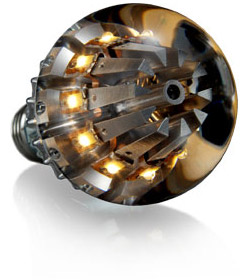LEDs have been in the news lately thanks to some advancements, deep price plunges and even some political drama. It’s all helping to heighten the lighting technology’s profile, but is it enough to make consumers sit up and take notice? Here are three stories that while loosely related on the surface, weave together to form a moment of truth for LED lighting manufacturers and marketers.
First, there’s this Slate piece about a startup called Switch Lighting that has conjured up the “holy grail of the lighting industry.” Did the company really develop a bulb that delivers the same warm light output of incandescents? Yep, according to the article’s initially skeptical author, Farhad Manjoo.
When I arrived at Switch, Brett Sharenow, the company’s chief strategy officer, showed me two lamps. Inside one was a standard 75-watt incandescent bulb. Switch’s 75-watt replacement bulb, which uses only 16 watts of power, was plugged into the other. The lampshades prevented me from seeing the bulbs directly—I couldn’t tell which lamp contained which bulb. When Sharenow turned on the lamps, the light from each lamp looked identical. The moment was completely undramatic, and that was the point.
Simply momentous. Right now, the two or three LED bulbs that you can buy at Home Depot fall way short of casting that warm, incandescent-like glow that separates a cozy family room from a harshly-lit hospital corridor. It’s a problem that plagued CFLs at first, but they have since improved. Thanks to Switch Lighting, it appears that soon homeowners won’t have to compromise between looks and the energy efficiency that LEDs offer. They can have both.
Oversupply = cheaper, better-quality LEDs
LEDs are efficient to operate, last long, and depending on the type of application, are easy to maintain. These cost savers make LEDs attractive, but the tech still has an ugly side: it’s expensive right out of the gate. But that too appears to be changing.
Though bad news for LED producers in Taiwan and South Korea, an oversupply of LEDs looks like it can send prices falling fast and shake out the less-than-quality-minded manufacturers. Mark Halper’s article for SmartPlanet explains.
“Rising inventory level led to severe price cuts,” states LEDinside. “Manufacturers even sold their LED inventories at low price to the lighting market, which in turn raised competitive pressure of the lighting market.”
…LEDinside believes that intensified competition triggered by the oversupply will help weed out junk.
“Only companies that attain superior product quality, cost management, and have a stable customer base and channel management can stand out in the market,” it states.
Junky LEDs are the last thing the market needs, especially at this stage. If this oversupply leads to big up-front savings and bulbs that can, in fact, last a couple of trouble-free decades, consumers are likelier to embrace LEDs. At the very least, this trend will help de-emphasize cost as a factor in LED purchasing decisions.
The politics of bulbs
The reaction by some people to looming bans on inefficient light bulbs — incandescents by and large — has been a curious one. Some people are stockpiling incandescent bulbs. Others have taken to Capitol Hill, albeit unsuccessfully, to overturn rules that they consider a huge government overreach. There is some merit to that line of thinking — who are you limit choice and dictate what kind of bulb I use?
But in the grand scheme of things, Americans have adapted well to efficiency standards that help consumers save money and preserve the environment. Take for instance today’s car market where 40MPG is the new 30 MPG. Perhaps that’s why Rep. Joe Barton’s (R-Texas) BULB Act (H.R. 2417) fizzled.
However, legislative incentives for these new bulbs hung precariously on the “BULB Act” (H.R. 2417 (pdf)), proposed by Rep. Joe Barton (R-Texas), which sought to repeal lighting provisions of the Energy Independence and Security Act (EISA) of 2007.
Approved during the George W. Bush administration, EISA established light bulb standards requiring manufacturers to develop 27 percent more efficient incandescent bulbs by 2014. Barton and other House Republicans cited the law as an example of government overstepping its boundaries and limiting choices for consumers.
Perhaps another reason that it failed is that it also ran counter another American trait: an innovative streak. Since the 2007 law, writes Umair Irfan, companies and startups alike got to work on improving LEDs, including firms that have the most to lose from outlawing incandescents, namely GE.
Where does that leave us? LEDs are politically safe (for now), getting cheaper and can reproduce the warm glow that consumers love and has come to define residential lighting for over a century.
A good place to be, indeed. All that’s left is to seriously start letting consumers in on the good news.
Image credit: Switch Lighting


Leave a Reply